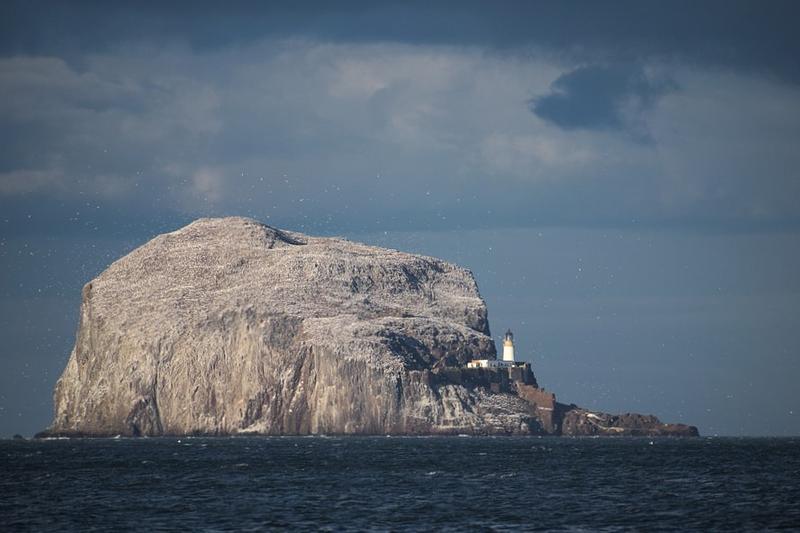_Jamie_McDermaid-2.jpg)
Local Islands
Just off the coast of North Berwick, a chain of four seabird islands span the skyline and are home to some spectacular wildlife.
The islands Fidra, Lamb, Craigleith and the Bass Rock are familiar landmarks to regular visitors. Many of these visitors are seabirds, several species of which return year upon year to breed, feed and raise their young. In fact, these islands are internationally important for their breeding seabird populations and are recognised for this through their designations as Sites of Special Scientific Interest (SSSIs) and as part of a larger Special Protection Area (SPA) under EU legislation.

The iconic Bass Rock in the Firth of Forth sits just 5 kilometres north east of North Berwick. At the peak of the season, this steep sided volcanic plug is home to the world's largest colony of Northern gannets.
The Bass is uninhabited but has a curious and diverse history. Settled by an early Christian hermit, it was later the site of an important castle, and from the 15th to 17th Century it was used as a prison. The substantial remains of the old castle still prevent access onto the island. The Bass now belongs to the Hamilton-Darlymple family, who acquired it in 1706. The Lighthouse, built in 1902 by David Stevenson, became automated in 1988.
In addition to the gannets, the lower ledges of the Bass are home to shags, guillemots and razorbills, with seals hauling up on the rocks below.
Enjoy the splendour of the Bass Rock from our remote cameras in the Discovery Experience or check in to watch the amazing wildlife from the webcams on our website.
Our range of seasonal boat trips to the Bass Rock are a fantastic way to see the wildlife up close. Click here for more information.
.jpeg)
The small rocky island of Fidra, an RSPB reserve, lies about 3 miles west of the Scottish Seabird Centre and just 300 metres from Yellowcraig Beach.
Robert Louis Stevenson is known to have visited Fidra during the construction of the lighthouse and the island may have been the inspiration for Treasure Island. Fidra is also mentioned in another book of his, Catriona.
The lighthouse, built in 1885 by David and Thomas Stevenson has been automated since 1970. Look out for the 4 flashes every 30 seconds, after nightfall.
With its grassy slopes and cliffs, Fidra is home to significant populations of shags, guillemots, razorbills, gulls and puffins. During spring there are fantastic views of nesting fulmars! Find out how we count seabirds here.
Puffins first nested on Fidra in the late 1960s and numbers built up slowly. Tree mallow (Lavatera arborea), a giant plant which grows up to nine feet high, reached Fidra in the 1990s and, as on Craigleith, it spread rapidly. By 2007 it covered roughly half the island, which is when volunteers stepped in and we started the SOS Puffin project. Work by the volunteers has since brought tree mallow under control, allowing puffins to nest. Breeding numbers in 2024 were over 900 pairs (counted as 'Apparently Occupied Burrows'). As on Craigleith, tree mallow control needs to continue each year to prevent mallow returning. Click here to find out more about our SOS Puffin project.
Enjoy the wildlife up close on Fidra from our two remote cameras from the comfort of our Discovery Experience and follow daily on our webcam links here.
_John_Hunt.JPG)
Craigleith is the closest of the four islands, just one kilometre from the Scottish Seabird Centre. The island is home to a rich variety of seabirds and marine life and it is a particular hotspot for puffins.
Craigleith was home to about 10,000 pairs of breeding puffins in the 1990s. However, numbers crashed dramatically due the invasion of the non-native plant tree mallow, which chokes puffin burrows and prevents the birds from nesting and rearing their chicks, known as pufflings. To tackle this problem the Scottish Seabird Centre set up a project called SOS Puffin in 2007, whereby work parties of volunteers make regular trips to Craigleith and the neighbouring islands of Fidra and the Lamb to cut down tree mallow.
To date, hundreds of work parties have made regular trips to the islands to keep the tree mallow under control. This has largely been achieved, and the amount of mallow which appears every year has slowly declined. The northern half of the Island is now mostly free of tree mallow, having been replaced with grasses. This has allowed puffins to breed again and for their numbers to recover.
SOS Puffin is supported and run entirely by volunteers. To find out more click here.
It is wonderful to see the puffins up close, why not take one of our seasonal boat trips to see for yourself? More details can be found here.
The Lamb is the smallest in this chain of islands in the Firth of Forth, nestled between Fidra and Craigleith.
Puffins first nested on the Lamb in the 1970s and numbers are thought to have increased gradually since then, although few burrow counts were attempted until 2015. A surprising 620 pairs of breeding puffins were counted, mostly nesting on the higher grassy part of this small island.
The spread of tree mallow here was less marked than on Fidra or Craigleith and had not encroached on the puffin nesting areas when SOS Puffin started. Occasional work parties have been sufficient to contain the spread of tree mallow and numbers have been steady over the last few years, with around 680 pairs of breeding puffins counted in 2018.
